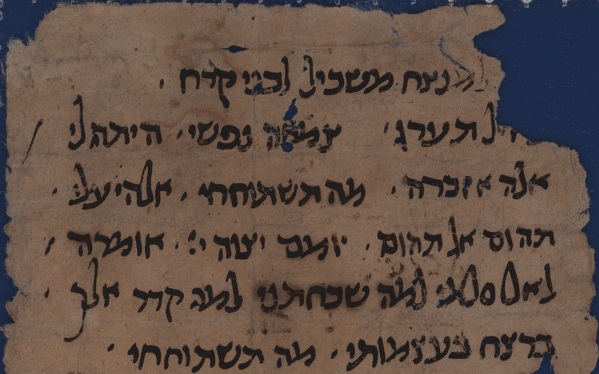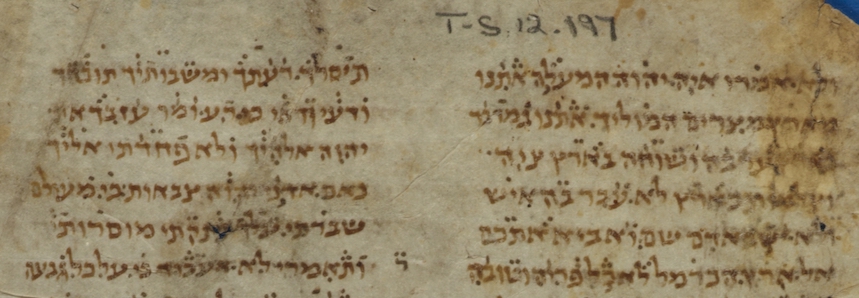The Bible of the Land of Israel: Re-Examining the Palestinian Vocalisation Tradition
Dr Kim Phillips has recently completed a four-year (part-time) project examining Genizah Bible manuscripts vocalised with the so-called Palestinian vocalisation (Niqqud Ereṣ-Yisraʾeli) in the Cambridge Genizah Collections. This form of vocalisation, which marks vowels above the consonants, is a system less complete, less uniform, and more ‘popular’ in character than the dominant Tiberian system. It is found only in manuscripts from the Cairo Genizah, where it is mainly used to vocalise liturgical poetry, rabbinic texts, targum fragments and the Hebrew Bible.
Despite pioneering work by Kahle, and more recent work by Dietrich, Chiesa, Revell and Yahalom, there remain many unanswered questions about both the system itself and the manuscripts that employ it. The project, which was mostly funded by a philanthropic foundation, interacted with previous reconstructions of the historical development of the Palestinian tradition found in biblical manuscripts, and found fresh evidence pertaining to this development in an unlikely place: one of the serugin fragments ('shorthand' Bible fragments, which present an abbreviated biblical text). This manuscript gives concrete evidence that, among at least some members of the Palestinian tradition, substantial efforts were made to imitate the prestigious Tiberian reading tradition. Phillips has suggested that these efforts are sufficient to explain the particular range of sub-systems apparent in the Palestinian tradition. In a similar vein, Phillips is currently using the data gleaned from his examination of the Palestinian fragments to propose a fresh understanding of the development of the Western cantillation system.
The most pioneering aspect of the project was the examination, description, and analysis of all the shorthand Bible fragments found in the Taylor-Schechter and Bodleian collections. Palestinian Bible fragments are substantially over-represented among this type of manuscript, and Phillips’ survey thus enables us to contextualise, for the first time, this particular sub-set of the Palestinian biblical materials. The overview revealed that there are three common modes of abbreviating the biblical text, and that these modes are largely dependent on the purpose for which the manuscript was produced. Manuscripts produced as aides mémoire use one of two modes of abbreviation. Either the first few words of each verse (and nothing more) were written in full, or the first letter (or few letters) of each word of the verse were noted. Consider, for example, this snippet of T-S A43.6, containing the abbreviated text of Psalm 42:

Section from the top of MS T-S A43.6 P2 recto
Here is a transcription of the MS’s representation of Psalm 42, with the elided text added in angle brackets:
1 למנצח משכיל לבני קרח
2 כאיל תערג <על אפיקי מים כן נפשי תערג אליך אלהים>
3 צמאה נפשי <לאלהים לאל חי מתי אבוא ואראה פני אלהים>
4 היתה לי <דמעתי לחם יומם ולילה באמר אלי כל היום איה אלהיך>
5 אלה אזכרה <ואשפכה עלי נפשי כי אעבר בסך אדדם עד בית אלהים בקול רנה ותודה המון חוגג>
6 מה תשתוחחי <נפשי ותהמי עלי הוחלי לאלהים כי עוד אודנו ישועות פניו>
7 אלהי עלי <נפשי תשתוחח על כן אזכרך מארץ ירדן וחרמונים מהר מצער>
8 תהום אל תהום <קורא לקול צנוריך כל משבריך וגליך עלי עברו>
9 יומם יצוה יהוה <חסדו ובלילה שירה עמי תפלה לאל חיי>
10 אומרה לאל סלעי למה שכחתני למה קדר אלך <בלחץ אויב>
11 ברצח בעצמותי <חרפוני צוררי באמרם אלי כל היום איה אלהיך>
12 מה תשתוחחי <נפשי ומה תהמי עלי הוחילי לאלהים כי עוד אודנו ישועת פני ואלהי>
As can be seen from the transcription, a high degree of familiarity with the biblical text would be required in order to successfully use this manuscript.
In contrast to this, manuscripts produced as condensed repositories of masoretic information (especially about the cantillation system) usually record the first consonant of the accented syllable of each word of the verse. Usually, though, more than simply the cantillation is preserved. T-S A43.1, for example, records sufficient vocalisation to aid a Palestinian reader to imitate the Tiberian text. Vowels are added precisely in phonetic contexts where the Palestinian dialect diverged most conspicuously from the Tiberian. Thus, Isaiah 6:3 is represented in the MS as follows:

(Image from Kahle 1901: 278)
The letters represented in the MS correspond to the highlighted letters in the full text as follows:

In the abbreviated version of Isaiah 6:3 above, only the מ of ואמר is written simply with a vowel, rather than, or in addition to, an accent sign. This is because in the Palestinian dialect of Hebrew, a pataḥ in a closed, accented syllable is extremely liable to be pronounced as qameṣ.
Bibliography
Ben David, Abba. 1958. ‘Review of Murtonen: Materials for a Non-Masoretic Hebrew Grammar’, Kiryat Sefer 33, 482–91.
Blau, Joshua, and Joseph Yahalom. 2017. ‘Typology of Manuscripts with Eretz Israeli vocalization’, Meḥqarim ba-Lashon 17–18, 95–116.
Chiesa, Bruno. 1978. L’Antico Testamento Ebraico Secondo La Tradizione Palestinese. (Torino: Bottega d’Erasmo).
Dietrich, Manfried. 1968. Neue palästinisch punktierte Bibelfragmente. (Publications de L’Institut de Recherche et D’Histoire des Textes: Section Biblique et Massorétique 2. Leiden: Brill).
Díez Macho, Alejandro. 1954. ‘Tres nuevos manuscritos bíblicos “palestinenses”’, Estudios Bíblicos 13, 247–65.
——— 1967. ‘Nuevo manuscrito bíblico “palestinense” procedente de la Genizah de El Cairo’, Studia Papyrologica VI:1, 15–25.
Dotan, Aron. 2008. ‘The Development of the Palestinian Sign System’, in Aharon Maman, Steven Fassberg and Yohanan Breuer (eds), Shaʿare Lashon: Studies in the Hebrew Language, Aramaic, and the Jewish Languages Presented to Moshe Bar-Asher (Jerusalem: Mosad Bialik). 128–39.
Fassberg, Steven. 1990. A Grammar of the Palestinian Targum Fragments from the Cairo Genizah. (Harvard Semitic Studies 38. Atlanta, Ga: Scholars Press).
Friedländer, Michael. 1895. ‘A Third System of Symbols for the Hebrew Vowels and Accents’, The Jewish Quarterly Review 7:3, 564–68.
——— 1896. ‘Some Fragments of the Hebrew Bible with Peculiar Abbreviations and Peculiar Signs for Vowels and Accents’, Proceedings of the Society of Biblical Archaeology 18, 86–95.
Harviainen, Tapani. 1977. On the Vocalism of the Closed Unstressed Syllables in Hebrew: A Study Based on the Evidence Provided by the Transcriptions of St. Jerome and Palestinian Punctuations. (Studia Orientalia 48. Helsinki: Societas Orientalis Fennica).
Kahle, Paul. 1901. ‘Beiträge zur Geschichte der hebräischen Punktation’, Zeitschrift für die Alttestamentliche Wissenschaft 21, 273–317.
——— 1927–1930. Masoreten des Westens. 2 vols, (Texte und Untersuchungen zur vormasoretischen Grammatik des Hebräischen. Stuttgart: Kohlhammer).
Khan, Geoffrey. 2020. ‘Some Features of the Imperfect Oral Performance of the Tiberian Reading Tradition of Biblical Hebrew in the Middle Ages’, In Aaron D. Hornkohl and Geoffrey Khan (eds), Studies in Semitic Vocalization and Reading Traditions (Cambridge Semitic Languages and Cultures, University of Cambridge: Open Book Publishers). 549–92.
——— 2020a. The Tiberian Pronunciation Tradition of Biblical Hebrew: Including a Critical Edition and English Translation of the Sections on Consonants and Vowels in the Masoretic Treatise Hidāyat al-Qāriʾ ‘Guide for the Reader’. 2 vols, (Cambridge Semitic Languages and Cultures. University of Cambridge: Open Book Publishers).
Klein, Michael. 1992. ‘Serugin (Shorthand) of Onqelos from the Cairo Genizah’. Maarav 8: 275–87.
Klein, Michael L. 1994. ‘Cairo Genizah Targum Texts: Old and New’. In The Aramaic Bible: Targums in Their Historical Context, edited by D.R.G. Beattie and M.J. McNamara. Journal for the Study of the Old Testament Supplement Series 166.
Neubauer, Adolf. 1895. ‘The Hebrew Bible in Shorthand Writing’, The Jewish Quarterly Review 7:2, 361–64.
Revell, Ernest John. 1969. ‘A New Biblical Fragment with Palestinian Vocalization’, Textus 7, 59–75.
——— 1970. Hebrew Texts with Palestinian Vocalization. (Belgium: University of Toronto Press).
——— 1970a. ‘Studies in the Palestinian Vocalization of Hebrew’, in John W. Wevers and Donald B. Redford (eds), Essays on the Ancient Semitic World (Toronto Semitic Texts and Studies, Belgium: University of Toronto Press). 51–100.
——— 1974. ‘MdW II, MS M, and Other Palestinian MSS with Defective Accentuation’, In Harry Orlinsky (ed), International Organization for Masoretic Studies (IOMS) Proceedings and Papers of 1972 and 1973 Meetings (Masoretic Studies 1, Missoula, Montana: Society of Biblical Literature). 149–57.
——— 1977. Biblical Texts with Palestinian Pointing and Their Accents. (Society of Biblical Literature Masoretic Studies 4, Missoula, Montana: Scholars Press).
Yahalom, Joseph. 1974. ‘Review of Ernest John Revell: Hebrew Texts with Palestinian Vocalization (1970)’, Kiryat Sefer 49, 214–22.
——— 1997. Palestinian Vocalised Piyyut Manuscripts in the Cambridge Genizah Collections. (Cambridge University Library Genizah Series 7, Cambridge: Cambridge University Press).
——— 2013. ‘The Palestinian Vocalization in Hebrew Language Traditions’. Lĕšonénu 75: 425–33.
Yeivin, Israel. 1962. ‘A Babylonian Fragment of the Bible in the Abbreviated System’. Textus 2 (1): 120–39.
Phillips, Kim. In progress. ‘T-S A43.3: The Naqdan’s Toolkit’.
——— forthcoming. ‘Abbreviated Bible Manuscripts in the Cairo Genizah—An Initial Survey of Form and Function’.
———. 2020. ‘A Shorthand Psalter: T-S A43.8’. Fragment of the Month (blog). May 2020. https://www.lib.cam.ac.uk/collections/departments/taylor-schechter-geniz....
———. 2022. ‘T-S A43.1+ and the Imitation of the Tiberian Reading Tradition’. Journal of Semitic Studies 67 (1): 61–98.
———. 2023. ‘“I Have Hidden Your Word in My Heart”—A Shorthand Mnemonic Psalter from the Cairo Genizah and the Memorisation of the Book of Psalms’. In Holistic Readings on the Psalms and the Twelve. Library of Hebrew Bible/Old Testament Studies. Bloomsbury.

